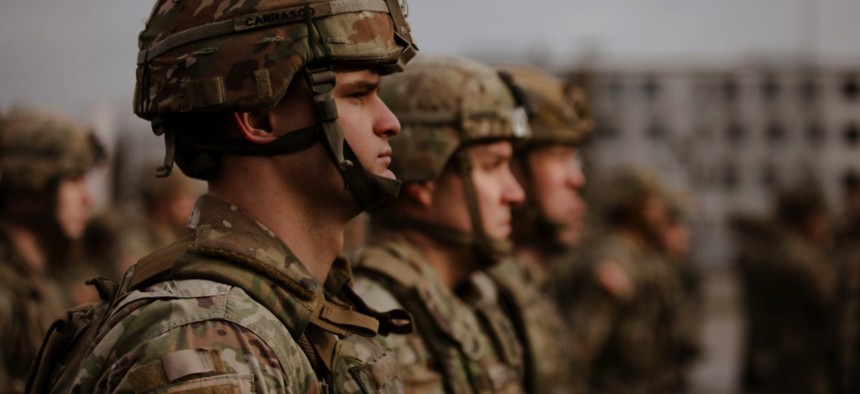
U.S. Army National Guard Soldiers assigned to 3rd Battalion, 161st Infantry Regiment, stand in formation during a handover/takeover ceremony at Bemowo Piskie Training Area, Poland, Feb. 11, 2022. U.S. Army / Sgt. 1st Class Adrian Patoka
Flat Army Budget Request Would Fund a Smaller Force
Active-duty force set to shrink amid tight labor market as service leaders propose a 1.7% 2023 budget.
The Army plans to pay more for fewer soldiers in 2023 as it struggles with a tight labor market and prepares to give the largest pay raise in decades. And despite the flat budget, the service’s six main modernization priorities remain well-funded under the budget proposal that went to Congress on Monday, said Army undersecretary Gabe Camarillo.
“This budget puts us on a sustainable strategic path to get to the Army of 2030,” Camarillo told reporters on Monday. “Our three priorities of readiness, people and modernization are all addressed. It enables our ability to maintain that high level of readiness…invests in key capabilities to support soldiers and their families. And then of course, maintains continuity on the modernization of our warfighting capabilities.”
According to service documents, the Army’s 2023 budget proposal includes a total of $177.5 billion.
The Army is asking for an increase in European Deterrence Initiative funding to $2.8 billion, including $942 million for “increased presence” with a rotation of a division headquarters, an armored brigade combat team, and additional units, Maj. Gen. Mark Bennett, the Army’s budget director, said during the briefing.
The active duty’s force’s operations and maintenance proposal would fund 22 combat training center rotations and an increase in flight hours.
“One of the best ways to take care of soldiers is to train them,” said Bennett. “And they like training and they like to focus on being ready to do their job. And readiness being one of the things that the Army has demonstrated this year, that it is able to bring to the table for our combatant commanders, both here with the Allies Welcome mission as well as we just demonstrated here recently in Europe.”
The budget would fund a third multi-domain task force, possibly geared towards the Pacific. The first was stood up at Joint Base Lewis-McChord to focus on Pacific operations and the second was stood up last year in Germany to work with U.S. European Command and Africa Command.
The Army is requesting $69.1 billion for personnel, up from $65.9 billion in 2022. That would fund a 4.6 percent pay raise and a 3.9 percent housing allowance increase beginning on Jan. 1. That pay raise, which applies to all service members, would be the largest in two decades, Deputy Defense Secretary Kathleen Hicks said Monday.
But while the Reserve and National Guard will remain the same size—189,500 and 336,000—the active duty force would shrink by 12,000 to 473,000.
In the face of a tough labor market, Army leaders decided to shrink rather than accept lower-quality recruits, Camarillo said.
“We made the assessment that we would not want to adjust our specific criteria for quality… And so we made the decision to just temporarily reduce end strength as opposed to lowering our standards,” he said. “So we don't anticipate that it is a lasting change, as we talked about earlier; it is something that we hope to bring back up.”
The Army is asking for $35 billion for research, development, and acquisition funding, down from $37 billion in 2022. Its six modernization priorities are still front and center in 2023, with the “unified network” receiving the most funding in 2023 at $1.9 billion. Earlier this year, Army Secretary Christine Wormuth said the network is probably the most important because of how the other capabilities like long-range precision fires will need to rely on it.
The budget pays for the prototyping of the Long-Range Hypersonic missile, with the first artillery battery receiving it in 2023, as well as the Precision Strike Missile and flight testing for the Mid-Range Capability missile.
Money for buying equipment continues to decrease, to $21.3 billion from $22.8 billion in 2022 and $24.1 billion in 2021. Among next year’s planned purchases are 35 AH-64E Apache helicopters, 120 Precision Strike Missiles, and more than 29,000 Next Generation Squad Weapons for several combat brigades.





